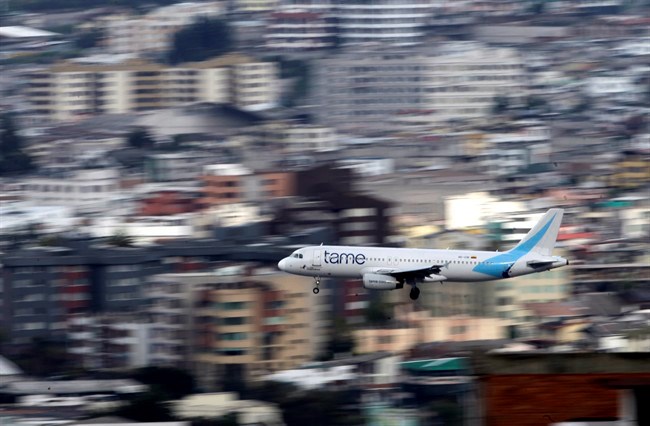QUITO, Ecuador - Landing at Ecuador's capital can be a white-knuckle affair. High altitude, a cramped runway and towering volcanos nearby make it one of Latin America's most challenging airports for pilots. And the constant roar of the planes torments those on the ground as well.
That will change on Feb. 19 as Quito moves its airport to an agricultural setting 12 miles (20 kilometres) northeast of the city, joining other cities that have moved — or tried to move — planes further from people.
Mariscal Sucre airport sat amid cornfields when it was christened in 1960. Over the years, Quito grew dense around it, turning the airfield into a notoriously nerve-racking neighbour, with planes booming in and out from 5:45 a.m. until 2 a.m. without rest.
"The racket of the planes sometimes woke us at dawn," said Maria Davila, 40, who has lived two blocks from the runway since she was a child. "The windows of the house would rattle and it seemed they would shatter."
"I often thought a plane would fall onto my house and kill all my family," she added. "The airport has been a bad neighbour, a very dangerous neighbour."
There are a lot more of those neighbours than when it opened. Just about 350,000 lived in Quito then. The population has grown to about 2.2 million now.
Over the course its life, Mariscal Sucre has seen 10 serious accidents. In 1984, a DC-8 owned by the company Aeca clipped some navigation aids on takeoff and plunged onto neighbouring homes. Forty-nine people were killed.
Fourteen years later, A Cubana de Aviacion Tupolev 154 failed on takeoff and slammed into the airport's wall, killing 76.
Most accidents were what the industry calls "runway excursions" — as in running off the runway. They tend to plague urban airports with minimal margins for error.
In addition to the cramped runway and nearby mountains, which force a steep angle of approach, the airport sits at an elevation of nearly 8,700 feet (2,850 metres), an oxygen-thin altitude that diminishes aircraft performance on takeoff and landing.
"You have to think ahead of the airplane a lot," said Ivan Rivera, an American Airlines captain with experience flying into Quito. "You have to be aware that those mountains aren't forgiving."
At that altitude, an aircraft must be travelling faster than normal at landing, and it takes longer to take off. And the zigzag, or corkscrew approach, can be unnerving.
Frequent air travellers, even those accustomed to the Andes' choppy air currents, can get anxious on approach to Quito, which handles about 220 departures and arrivals a day, carrying an average of 451,000 passengers a year.
Growing up with the constant roar of jets surging skyward in their midst has engendered fatalism in some neighbours.
Fernando Araujo, a 22-year-old university student, plays soccer just outside the northern end of the runway and said he's not bothered by the gleaming hulks of steel that pass just over the field.
"I'm not at all afraid. We're accustomed to the planes' takeoffs and landings," he said. "Only God knows when we'll be taken, so we're relaxed."
The new airport at Tababela is built to handle 290 flights a day and has a runway 4,100 metres (13,450 feet) long. That's nearly 1,000 metres (3,300 feet) longer the soon-to-be shuttered airfield.
Other cities in the region have tried to move airports to less troublesome sites. Honduras is planning to move most airline flights out of notorious Toncontin airport in Tegucigalpa, whose short runway and urban location make it the region's most dangerous major airport by many accounts. It was closed to commercial jets in 2008 for six weeks after a Taca A320 jet ran off the runway and into a busy street, killing five, including two on the ground.
Land disputes, however, have frustrated efforts to move Mexico City's airport to more spacious terrain further from the urban sprawl.
Tight space has led the tiny Caribbean islands of St. Barts, St. Maartin and Saba to put up with airports widely considered among the most hair-raising in the world.
Quito's new airfield, which also carries the name of 19th-century independence leader Antonio Jose de Sucre, is bordered by cropland and encompasses nearly 6 square miles (15.5 square kilometres), twelve times the area of the old airport, most of which will now become a public park.
As runway becomes grassy esplanade, a flurry of construction is anticipated nearby. The newly revised code will allow for buildings as high as 40 stories, up from the current four.
"I can't even imagine what it's going to be like without all the noise and fear," said Francisco Cahuines, whose construction supply business borders the airfield's northern end.
There will, however, be one big drawback.
While the old Mariscal Sucre could be reached from downtown in 20 minutes or so it will take at least an hour to get to the new airport, and no train-to-the-plane is yet planned.
---
Associated Press Writer Frank Bajak in Lima, Peru contributed to this report.



